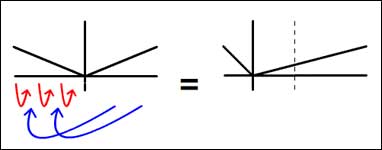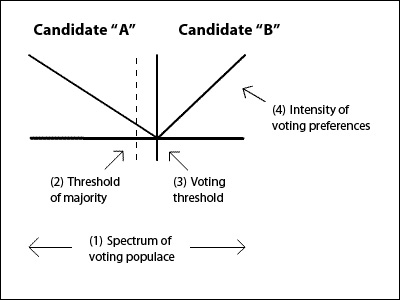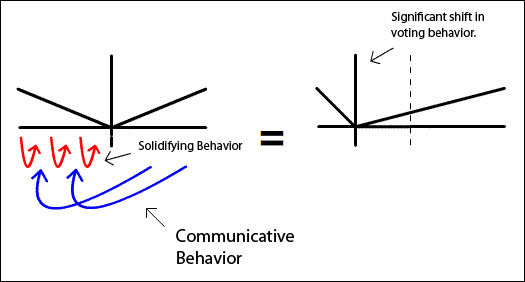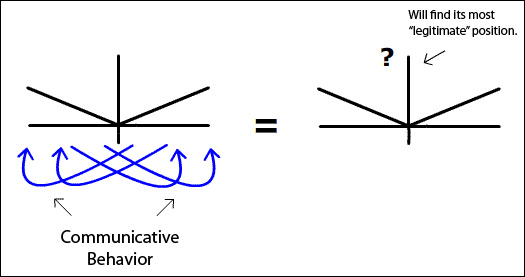Deriving the Most Effective Activist Communication for Creating Political Change
by Edward Ulrich, updated February 18, 2020

[Note: February 18, 2020— I have updated this article including reworking its illustrated graphs.]
This article is a study of potential types of politically motivated communication styles and the practical voting results arising due to such communication, by means of graphing theoretical voting results.
Communication style can be “communicative” to win the support of those being communicated with, or “solidifying” which entrenches people’s opinions on both sides of an issue. This article describes aspects of the two styles and conducts a theoretical study of the practical voting results of the styles being used against each other. It is shown by graphing theoretical voting results that effective “communicative” style will always trump the effects of “solidifying” style.
This article defines the terms used, offers graphical representations of the ideas being presented, and draws conclusions based on the results of study.
Jump to parts of this article ..
Definitions of Key Comminication Styles
”Communicative” Communication Behavior — “Focusing efforts on effectively communicating ideas to people who either disagree with those ideas or are unfamiliar with them.”
Communicative communication style helps to win people over to one’s point of view. Applied with political communication, this translates to moving the “voting line” to the favor of the ideas which are presented, assuming that the ideas being communicated can be shown to be legitimate. The following charts in this article help to illustrate the concept.
”Solidifying” Communication Behavior — “Focusing efforts on communicating ideas to people who already share those views, while angering or generally neglecting to effectively communicate to people who do not share those views.”
As the following charts illustrate, Solidifying communication style works to entrench opinions on both sides of an issue and works to “solidify” the position of the voting line.
Charts of the Voting Spectrum
These charts represent the spectrum of the votes of the populace, and demonstrate the intensity of the voting preferences as well as the actual votes. These charts assume a choice between two candidates in a democratically decided election.

A description of the elements in the above chart are as follows:
(1) Spectrum of voting populace — This graph represents the entire spectrum of all voters in a given election.
(2) Threshold of majority — This line is in a fixed position exactly in the middle of the voting spectrum. It represents the point of majority vote.
(3) Voting threshold — This line’s position is determined by the percentage of votes received by the candidates. When the voting threshold falls to one side of the threshold of majority, the other side wins the election.
(4) Intensity of voting preferences — The slope of this line roughly represents the intensities of the voting preferences for a particular candidate. The steeper the slope, the stronger the preferences for voting for that candidate.

Chart #1: Both sides exhibiting “Solidifying Behavior.”
Following are interpretations of Solidifying Behavior from the above graph:
— Contributes to increased intensity of feelings of those people who already share the views being communicated.
— Contributes to increased intensity of feelings of those people who oppose the views being presented in that manner.
— Entrenches people’s existing ideas, the voting line does not significantly move, and it may move away from the favor of the individual exhibiting Solidifying Behavior.
— It would be theoretically possible for someone on the “other side” to agree with what is being said through Solidifying Behavior, but it is the exception to the rule.
— It helps to block the potential for loosing one’s support base, and it also hinders potential for the growth of one’s support base. However it is an effective strategy for blocking loss of support only if the other side engages in Solidifying Behavior as well and does not effectively engage in Communicative Behavior.

Chart #2: One side exhibiting “Solidifying Behavior,” the other side exhibing “Communicative Behavior.”
Following are interpretations of Communicative Behavior vs. Solidifying Behavior from the above graph.
— Communicative Behavior is tailored for effective communication to all, including those who currently do not agree with the views being communicated.
— Communicative Behavior directed toward the “other side” will counter any attempted Solidifying Behavior of the other side due to the fact that Communicative Behavior exposes the flaws of the Solidifying Behavior in the eyes of the people being communicated to.
— If the message being conveyed through Communicative Behavior is verified as legitimate and being communicated effectively, it will trump the effects of Solidifying Behavior.
— Communucative Behavior is the most effecient means of shifting the voting line through winning people over who previously were unaware or did not agree with what was being communicated.

Chart #3: Both sides exhibiting “Communicative Behavior.”
Following are interpretations of both sides exhibiting Communicative Behavior from the above graph:
— Both sides actively and effectively communicate with each other.
— The voting line will seek its most “optimum position” based on the entire voting populace being more well informed on the issues.
Steps for ensuring that your efforts are “Communicative” based
Tailor your message to be acceptable to as broad of a spectrum of people as possible.
Seek out and effectively communicate to people who do not share your point of view.
Be sensible of the perceptions of the people who you are communicating with in order to communicate your ideas without causing agitation.
Be sure that you have specific evidence to back up the facts being presented.
Continually modify your views based on newly accumulated knowledge and thoughts.
Identify and criticize a problem while avoiding insulting those who currently do not identify it as a problem.
While criticizing a politician, do so while avoiding insulting the people who are currently planning on voting for that person.
Be wary of having your thoughts dictated and reinforced by “group think.”
Seek out criticism and offer criticism without malice, bias, or agenda. Criticize yourself.
Be ethical in your intentions and actions.
Be willing to say “I don’t know.”
Don’t overly identify yourself with any particular point of view to the point of not being able to change your mind if necessary.
Avoid identifying with any particular political point of view to the point of accepting what you do not believe in.
Don’t attach “pride” to enforcing any particular point of view to the point of being inflexible.
Do not view an exchange of ideas as a “sporting event” by taking an “us vs. them” mentality.
Don’t take a confrontational approach with your communication.
Strip all bias words and anger from your communication.
If your idea has merit, it is theoretically possible to effectively communicate it to anybody.
Tailor your message to be acceptable to as broad of a spectrum of people as possible.
Seek out and effectively communicate to people who do not share your point of view.
Be sensible of the perceptions of the people who you are communicating with in order to communicate your ideas without causing agitation.
Be sure that you have specific evidence to back up the facts being presented.
Continually modify your views based on newly accumulated knowledge and thoughts.
Identify and criticize a problem while avoiding insulting those who currently do not identify it as a problem.
While criticizing a politician, do so while avoiding insulting the people who are currently planning on voting for that person.
Be wary of having your thoughts dictated and reinforced by “group think.”
Seek out criticism and offer criticism without malice, bias, or agenda. Criticize yourself.
Be ethical in your intentions and actions.
Be willing to say “I don’t know.”
Don’t overly identify yourself with any particular point of view to the point of not being able to change your mind if necessary.
Avoid identifying with any particular political point of view to the point of accepting what you do not believe in.
Don’t attach “pride” to enforcing any particular point of view to the point of being inflexible.
Do not view an exchange of ideas as a “sporting event” by taking an “us vs. them” mentality.
Don’t take a confrontational approach with your communication.
Strip all bias words and anger from your communication.
If your idea has merit, it is theoretically possible to effectively communicate it to anybody.
Conclusions
According to the results of this theoretical study, exhibiting Solidifying communication and encouraging Solidifying communication in one’s opponent is an option often used by those who feel that they would not be able to win in a legitimate debate and are mainly worried about loosing their existing support base. Solidifying communication is only effective if the other side engages in such behavior as well, Communicative communication will always trump Solidifying communication. See chart #1
By contrast, if someone is interested in expanding their support base by winning people over, and they feel that they could win in a legitimate debate, then it would be entirely counterproductive to their cause to exhibit Solidifying communication. Solidifying communication blocks increases in one’s support base in the same manner that it is used to counter the potential for “shrinking support.” See chart #1
If one feels that their ideas are legitimate enough to be communicated through the process of Communicative communication, then directing their efforts in that way would certainly help to move the position of the “voting line” in their favor through winning people over who initially did not agree with them. See charts #2 and #3
Article Tree
| Creating Political Change Through Communication and Legislation |
| A Summary of Political Activism Issues |
| Deriving the Most Effective Activist Communication for Creating Political Change |




















